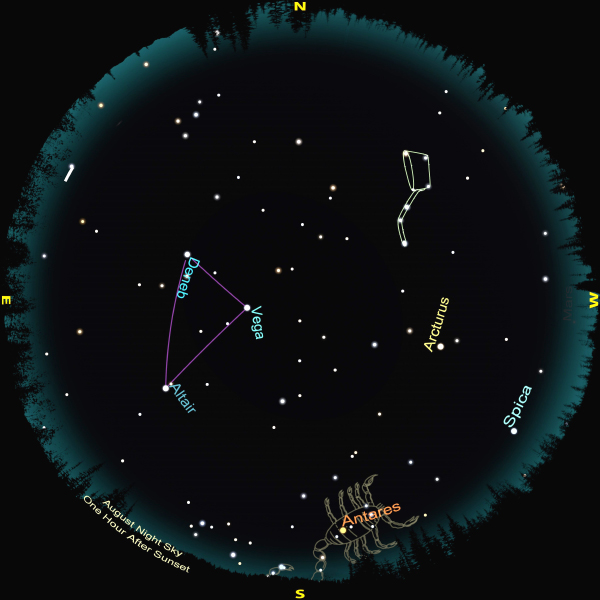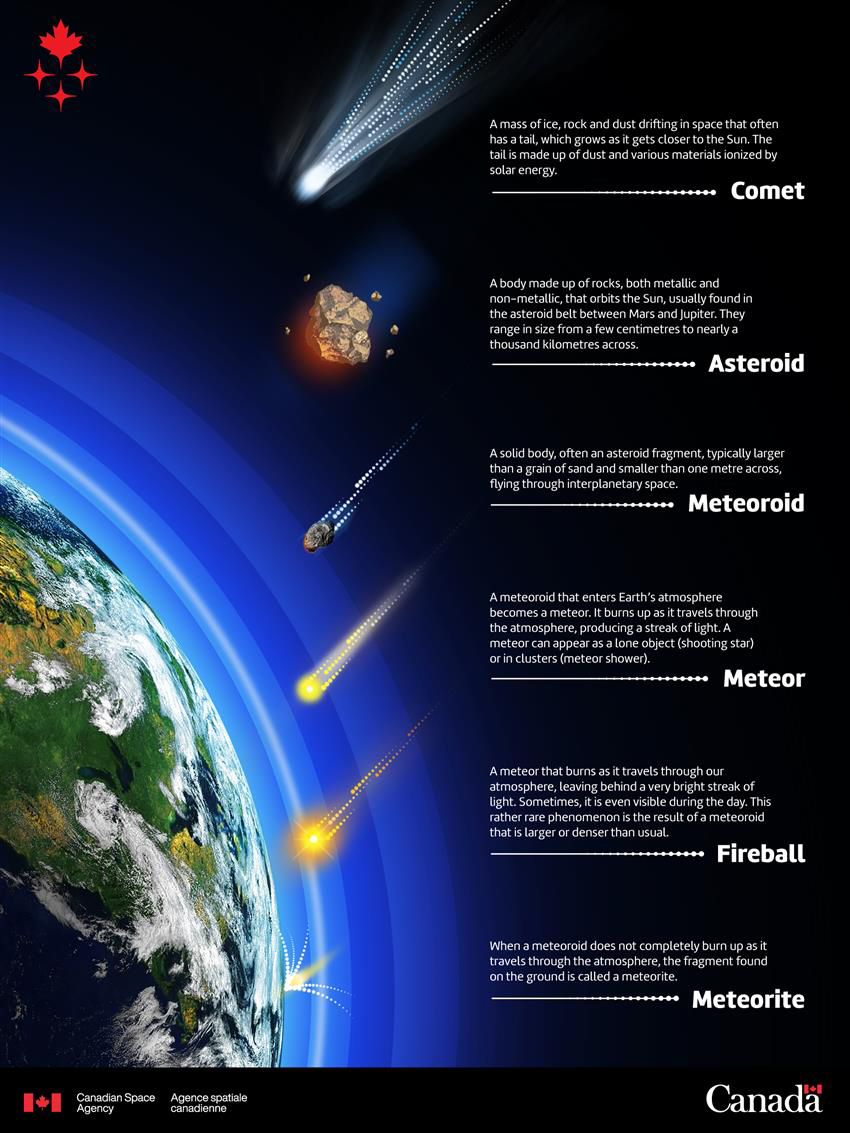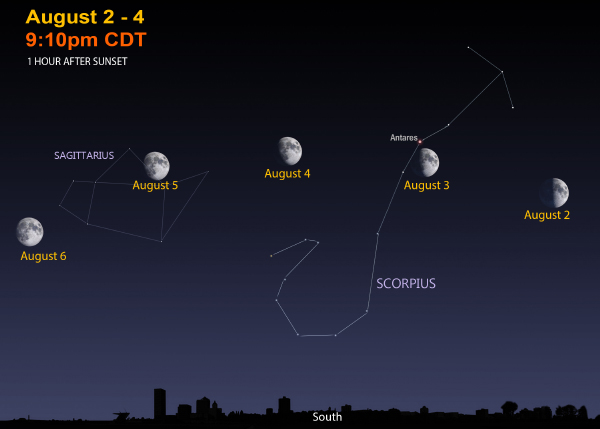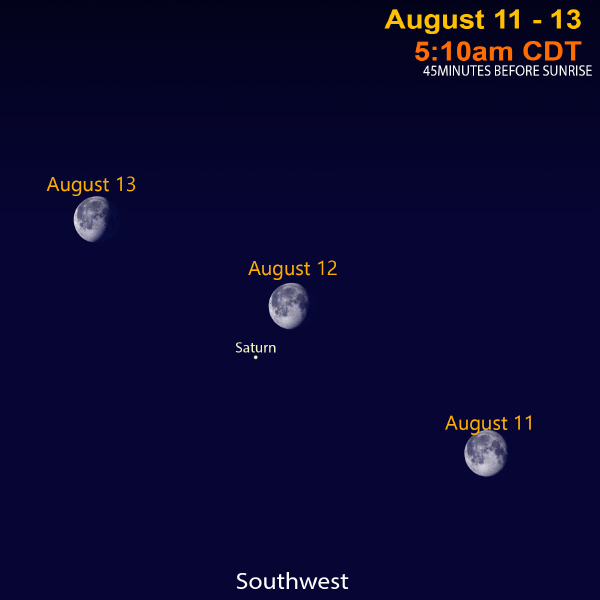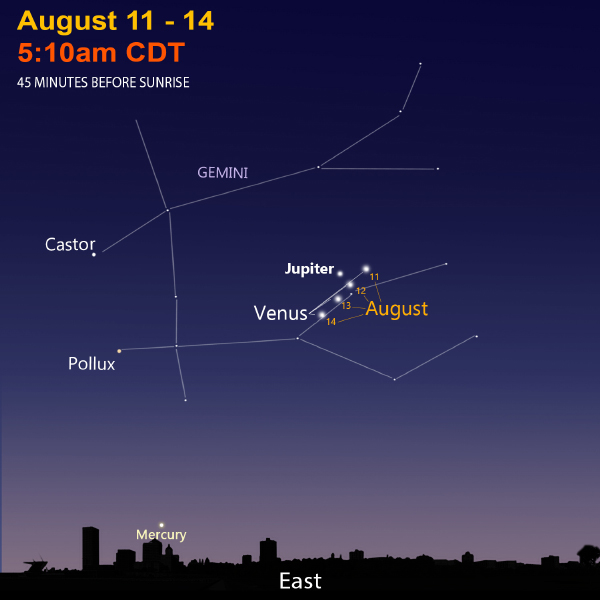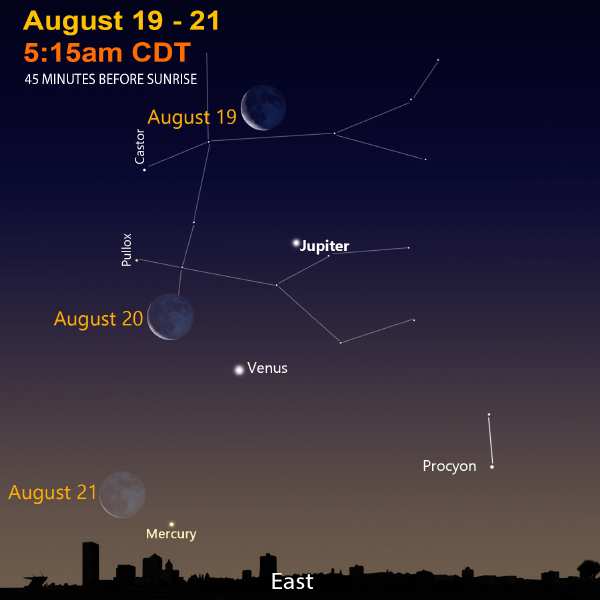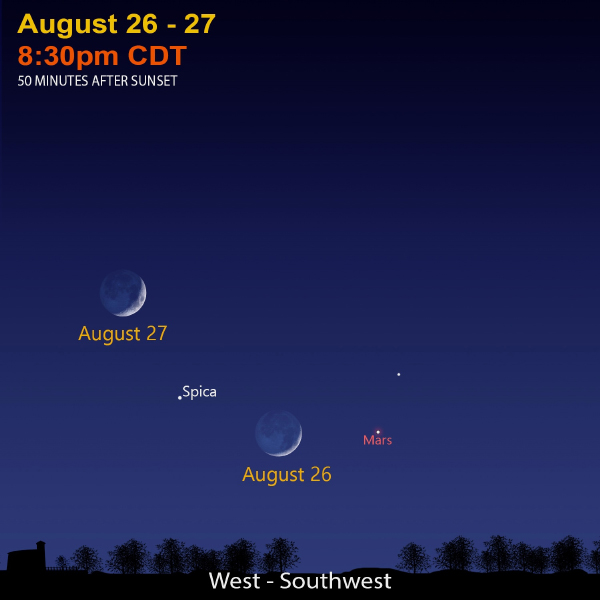Cosmic Curiosities
“It's not imagination on my part when I say that to look up at the sky, the clouds, the moon, and the stars make me calm and patient. It's a better medicine than either valerian or bromine.”
- Anne Frank, The Diary of a Young Girl
Young and Old Stars
Most bright stars we see at night are young, distant, and larger than the sun. Being so big, they fuse through their hydrogen supply much faster and live “only” millions of years! They live life in the fast lane. Our sun is taking a much slower road. It is middle-aged at 5 billion years old, and will live another 5 billion years.
Credit: MPM
Above is the August night sky about one hour after sunset. Notice the six brightest stars. Three are high above in the summer triangle—Vega, Altair, and Deneb. More to the west and south, we find Antares, Arcturus, and Spica.
| Star | Current Age in Years | Years Left to Live | Type of Demise |
|---|---|---|---|
| Vega | 450 million | 500 million | Red Giant, White Dwarf |
| Altair | 100 million | 2 billion | Red Giant, White Dwarf |
| Deneb | 10 million | 2 million | Super Red Giant, Supernova |
| Antares | 15 million | 1 million | Super Red Giant, Supernova |
| Arcturus | 7 billion | 1-5 billion | Red Giant, White Dwarf |
| Spica | 12 million | 10-20 million | Super Red Giant, Supernova |
Notice Arcturus is the only older star, like the sun. The other August bright stars live only millions of years, though Vega may live to be a billion. These six stars are very representative of all the bright stars we see at night. The sun is 500 times older than the bright star Deneb! And our star will live 5,000 times longer. For comparison, I am four times older than my grandson. (Sorry, we are not giving away our ages here!)
Stars like the sun do not have the longest lifetimes—red dwarf stars have that honor. They will live for trillions of years. Red dwarfs are also the most plentiful, comprising about 80% of all stars.
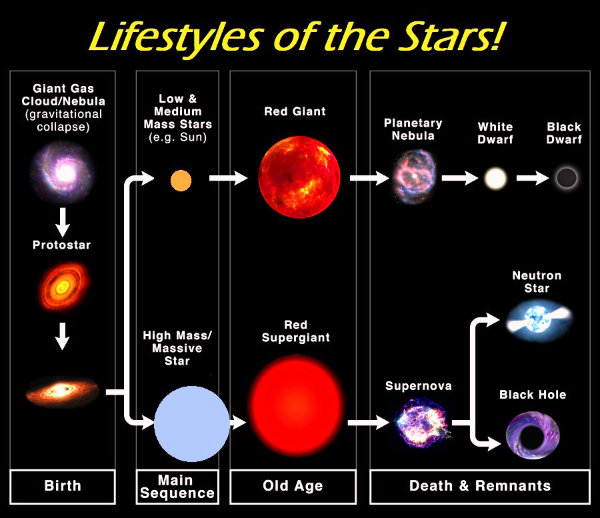
These numbers (million, billion, and trillion) are so large they can seem all the same, but they are very different. Think of them in time: How long is a million seconds, etc.:
- A million seconds is about 12 days.
- A billion seconds is almost 32 years.
- A trillion seconds is 32,000 years!
Stars all work the same way—nuclear fusion—but they have very different lifestyles! Some are young. Some are old.
Space Rocks!
Have you ever seen a shooting star streak across the sky? Sometimes they are quick and faint—barely noticeable. Other times, if you are lucky, a bright one dazzles your eyes for seconds. These are called fireballs, and a few folks have heard them hiss! The proper name for one of these night lights is a meteor. It is from the Greeks: Meteōros means "high in the air." A meteor is a small rock that enters our atmosphere. If part of the rock hits the Earth, it's called a meteorite. A meteoroid is a rock in space that may or may not hit the Earth.
On a bigger scale, we track as many comets and asteroids as possible. The chart from Canada spells out all the various space rock definitions.
Credit: Canadian Space Agency
A meteor's light comes from the rapid compression of the gas right in front of the asteroid. A meteor impacting our atmosphere can be traveling at speeds of 10 to 40 miles per second! The speed causes the air in front to compress and get hotter. This kinetic energy causes the atoms to ionize and excite. This hot glowing air is mainly what you see. The small rock vaporizing is tiny. Most meteors are no bigger than a grain of sand. This meteor process is also called ablation.
A meteor may burn quickly or slowly through our atmosphere. During the evening sky before midnight, a meteor must “catch up” with the Earth's spin and thus tracks more slowly across the sky. After midnight, or in the morning sky, they hit the air head-on and produce faster flashes of light. This is also why we see more meteors in pre-dawn skies.
Meteors are not that rare. On a typical moonless night, far from streetlights, you might see about four to six per hour. During meteor showers—when the Earth intersects with comet debris—you might see 15 to 60 meteors per hour. The Perseids in August and the Geminids in December are two of the best meteor showers.
The Earth is hit by more than 48.5 tons of meteoric material every day! Most of this debris is microscopic and not visible. If you are wondering why these meteors are not big news, remember, 71% of the Earth's surface is water! And us humans occupy less than 0.5% of the remaining 29%.
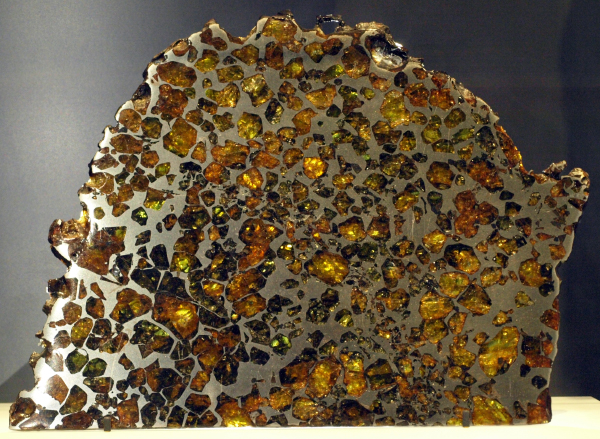
Sony Iron Meteorite; Credit: Captmondo 2009, Wikimedia Commons
The composition of meteors is a key factor in their brightness. Typically, the bigger the rock, the brighter the meteor. Also, if a meteor is comprised of dense stony or metallic material—like the stony iron one above—their streak across the sky can be more luminous because it takes longer for the heavier metals to burn up.
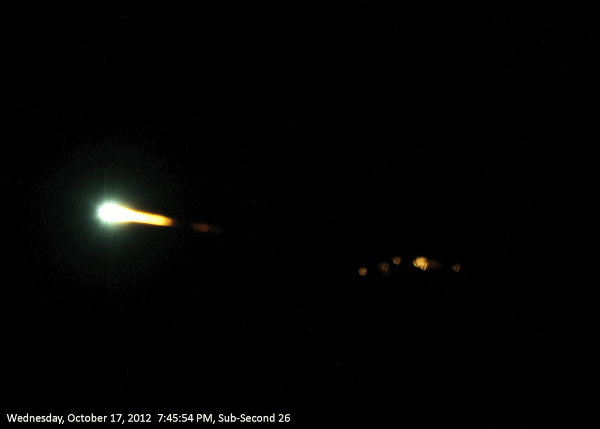
Credit: NASA
The Perseids are coming up this month; the best time is the morning of August 13. However, a bright moon will wash out many of the fainter Perseids. Still, there is a great chance to witness a few bright ones in the pre-dawn sky.
The Perseids are tiny rock and ice debris from Comet Swift-Tuttle. They emanate from the constellation of their namesake, Perseus, which rises about midnight and is high in the sky one hour before sunrise. The Perseids are well known for fireballs. So, give them a peak if the skies are clear and enjoy the cosmic light show!
Vera Rubin
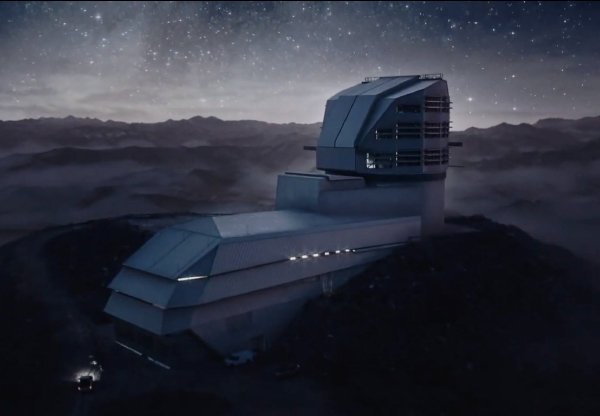
Credit: NSF Vera Rubin Observatory
Remember three years ago when everyone was all excited about the photos from the recently launched James Webb Space Telescope? Well, astronomers are pumped up again and it is because of a new observatory: the Vera Rubin Observatory!
But who is Vera Rubin, why did we name an observatory after her, and what is so special about it?
Vera Rubin is a world-famous astronomer born in 1928 in Philadelphia. When she was a young girl, her family moved to Washington, DC, where she developed an interest in astronomy through watching the stars out of her bedroom window.
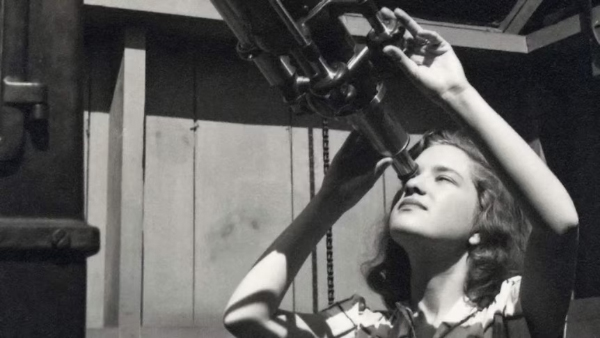
Credit: Vassar College Archives
Vera earned her bachelor's degree in astronomy at Vassar College in 1948, her master's degree from Cornell in 1951, and her PhD from Georgetown in 1954. Her research provided some of the earliest evidence of galactic clustering.
Vera Rubin had to overcome a lot of criticism and barriers on account of her gender. She was not admitted into Princeton's graduate program for astronomy because she was a woman. Other astronomers would ask her about her work but then deny her access to their lectures, because she was a woman. But Vera often took such discouragements in stride. When her research adviser at Cornell tried to pressure her into letting him present her Master's thesis at a conference in his name, she refused and presented it herself while she was nine months pregnant.
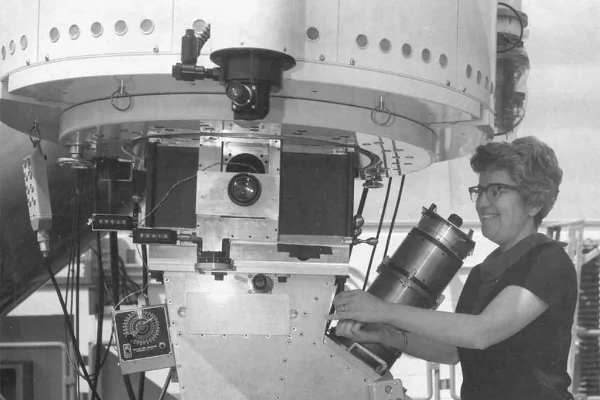
Credit: NOAO/AURA/NSF
She applied to work at the Palomar Observatory in California. She was told her time would be limited since they had no women's bathroom. In response, she taped a paper skirt over the male icon on the door, said, “There, now you have a women's bathroom,” and got on with her work.
After her graduate studies, Vera went on to study at Carnegie Institution's Department of Terrestrial Magnetism. Here, she completed the work she is most famous for: proving the existence of dark matter.
Credit: NASA
Stars orbit around the centers of their galaxies, just like planets orbit around their suns. The strength of gravity experienced by a star—and with it, its rotational velocity—decreases with the orbital distance and increases with the amount of mass enclosed within that distance.
Based on this, it was expected that if you observed the orbital velocity of stars in other galaxies, we would see their speeds increase up to a peak and then drop back down as you get to the edge of the galaxies where there are no more stars. But thats not what Vera Rubin found.
In studying the rotational motion of spiral galaxies such as Andromeda, she noticed that stars and gas clouds at the outer reaches of the galaxies were orbiting just as fast as those close to the center. Based on the amount of visible matter in these galaxies, these rotational velocity observations seemed impossible! The galaxies should have been tearing themselves apart by rotating so fast with so little mass to hold everything together.
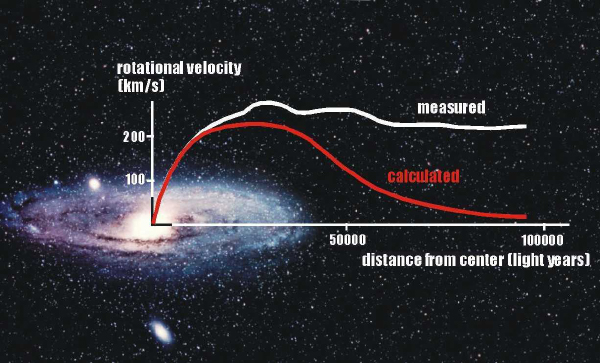
Credit: Phys.org
Vera Rubin determined that for rotational speeds to stay constant like this, there was likely some sort of invisible matter that still had a gravitational influence but could not be detected through light. This unseen substance is known as dark matter. Earlier astronomers had predicted the existence of dark matter based on observations of galaxy clusters, but Vera's calculations provided proof!
Today, we know that each major galaxy has a halo of dark matter beyond its visible edge. There is typically 10 times as much dark matter in a spiral galaxy as visible matter. Cosmological calculations suggest that dark matter makes up 25% of the mass-energy composition of the entire universe. In general, there is five times more dark matter than there is “normal” matter.
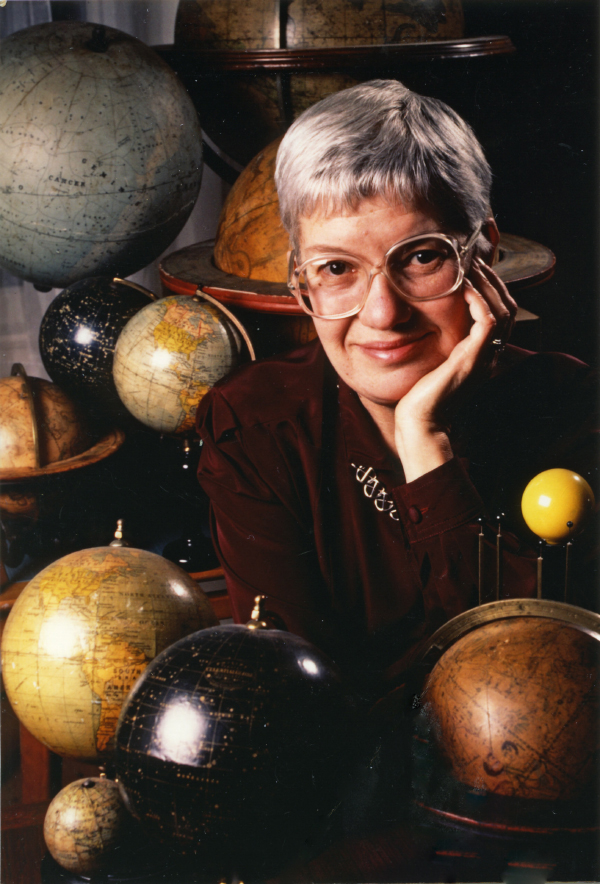
Credit: Mark Godfrey, courtesy of Carnegie Science
Even though it has been roughly 60 years since Vera Rubin discovered evidence of dark matter, we still do not know what dark matter is. That is what the Vera Rubin Observatory is for. Among other things, this new observatory hopes to gain a better understanding of the nature of dark matter and dark energy.
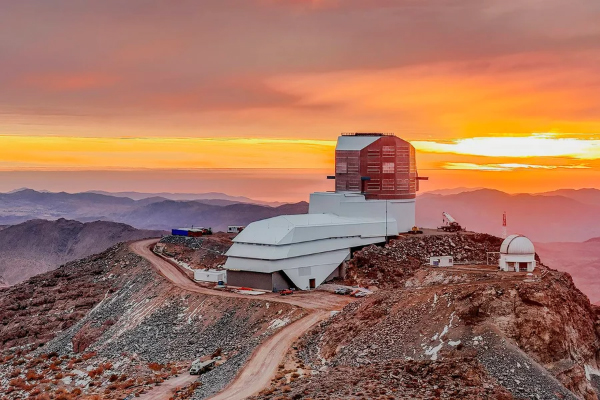
Credit: Olivier Bonin/SLAC National Accelerator Laboratory
Located on a mountaintop in Chile, the Vera Rubin Observatory utilizes an 8.4-meter telescope, and the largest digital camera ever built to map out our solar system, galaxy, and universe. The photos that have recently been released are amazing!
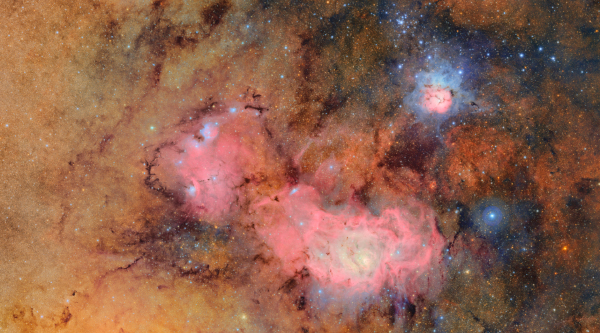
Credit: NSF–DOE Vera C. Rubin Observatory
The above picture combines 678 separate images taken in seven hours of observing time. Combining multiple images reveals faint or invisible details, such as the clouds of gas and dust. This picture shows both the Trifid nebula (top) and the Lagoon nebula, which are both located in the constellation Sagittarius and are about 5,000 light-years away from Earth.
This new telescope can photograph the entire southern hemisphere sky in only a few nights! Astronomers plan to use this ability to create a timelapse movie of the universe that spans the next 10 years. This will give us a new and groundbreaking look into how different celestial objects change and move over time—bringing on a new era of astrophysics and a better understanding of our universe!
Space in Sixty Seconds
Who are the young and old stars? What's up with Venus and Jupiter getting so close? Find out in the August night sky!
Sky Sights
Watch a waxing gibbous Moon move low across the southern sky in the constellations Scorpius and Sagittarius from August 2 to 6.
Saturn and the Moon pair up from August 11 to 13. On August 1, Saturn rises by 10:30 p.m., and by month's end, it rises by 8:30 p.m.
Early risers, catch bright Venus and Jupiter very close together on August 12, when they will be only one degree apart. See the whole sequence as faster Venus passes slower Jupiter from August 11 to 14.
The waning crescent Moon joins the two bright planets from August 19 to 21. Notice how far apart Venus and Jupiter are just five days later.
Mars moves into the constellation Virgo this month. It is a little hard to spot being so low in the sky. Use the crescent Moon to guide you to the red planet and the bright blue star Spica on August 26 and 27.
Mercury can be glimpsed in the early morning sky. The best times will be mid-to-late August.
August Star Map
Sign Up
Receive this newsletter via email!
Subscribe
See the Universe through a telescope
Join one of the Milwaukee-area astronomy clubs and spot craters on the Moon, the rings of Saturn, the moons of Jupiter, and much more.
Follow Bob on social media
Twitter: @MPMPlanetarium
Facebook: Daniel M. Soref Planetarium


